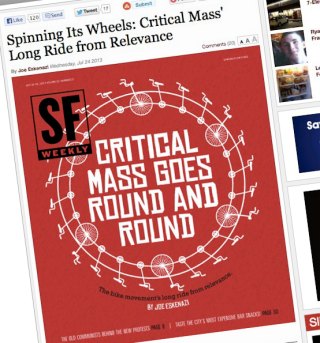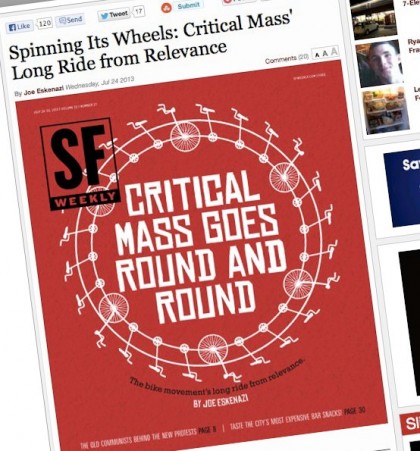
Here’s the bike news that caught our eyes this week…
Cities are safest: “Want to keep your family safe? Then raise your kids in the city.” Rural areas are statistically more dangerous, and we’ll give you one guess as to the type of injury to blame.
History of jay walking: Before auto companies could successfully appropriate rural technology for urban transportation, we had to “socially reconstruct” the city street as a place where only country rubes (“jays”) would cross without looking both ways … and maybe get sued for it.
Vibrating bike seat: Hey, whatever gets more people in the saddle.
Auto enforcers: Two representatives from auto company Citroën paid an unexpected house call to Mikael Colville-Andersen after his blog Copenhagenize ran an video satirizing auto industry advertizing by noting that cars kill. He took it down.
Biker, 15 points: A 26-year-old Redlands man is under arrest for allegedly using his Honda Civic to deliberately sideswipe people on bikes.
Bike lanes, at last: “It took two years of love, perseverance, and collaboration” for Brooklyn’s poorest neighborhood to get the valuable amenities that another group has fought tooth and nail in one of Brooklyn’s richest.
Women’s racing advances: With the statement by the race’s owner that a “women’s Tour de France” is possible, the campaign for women to get equal footing in bike racing is rolling fast.
The decline of Critical Mass? The co-founder of the movement “has observed a five-year ‘golden age’ before they ‘lose their magic’ and become institutionalized rituals,” according to SF Weekly’s cover story.
Speaking of Critical Mass, Portland-based documentary journalist and publisher Joe Biel has finished his 74-minute film on the subject. Biel started working on Aftermass – Bicycling in a post-Critical Mass Portland five years ago and he just sent it out to film festivals around the globe. (Stay tuned for more coverage.)
The secret to bike transportation: home location. Yahoo interviews a finance columnist who recommends saving $12,000 to $15,000 per year by replacing car trips by bike. The trick: figuring out what parts of your town are bike-friendly, and prioritizing that next time you move. (We couldn’t agree more.)
Congestion prediction: Walk Score’s latest home-searching tool estimates auto travel times during rush hour.
Bike industry analysis: You know bicycle manufacturing is coming into its own when financial analysts start tracking it in depth.
Bikes spice up Detroit: Bicycling.com’s Elly Blue reports on a Sunday “Bike & Brunch” ride organized last year by a group of mostly young black Detroiters whose main operating rule is “NO NEGATIVITY WHAT SO EVER.”
Armstrong back on a bike: He joined the Register’s Annual Great Bicycle Ride Across Iowa “for fun” last week and told the media “‘my bad’ for ‘playing along’ with doping.”
Greener states: Carbon emissions from Oregon and Washington didn’t rise from 2007 to 2010 despite population growth, thanks in part to less driving per capita.
Street redesigns needed: British doctors say helmets help minimize brain injury but don’t prevent the more common causes of death on a bike: chest and pelvic injuries. Good street design is essential, they say.
Not so swamped: Streetfilms asks Dutch experts if they feel “swamped by a sea of bicycles.” “The success is a challenge, but not a problem,” says Amsterdamize’s Marc van Woudenberg.
Do sharrows work? Lots of people don’t know what the shared lane markings mean, CBS Los Angeles says.
Cargo bikes in NYC: In your video of the week by Edible Manhattan, the owner of two New York restaurants says “I can’t imagine why every business doesn’t have their own cargo bike.”
If you come across a noteworthy bicycle story, send it in via email, Tweet @bikeportland, or whatever else and we’ll consider adding it to next Monday’s roundup.

